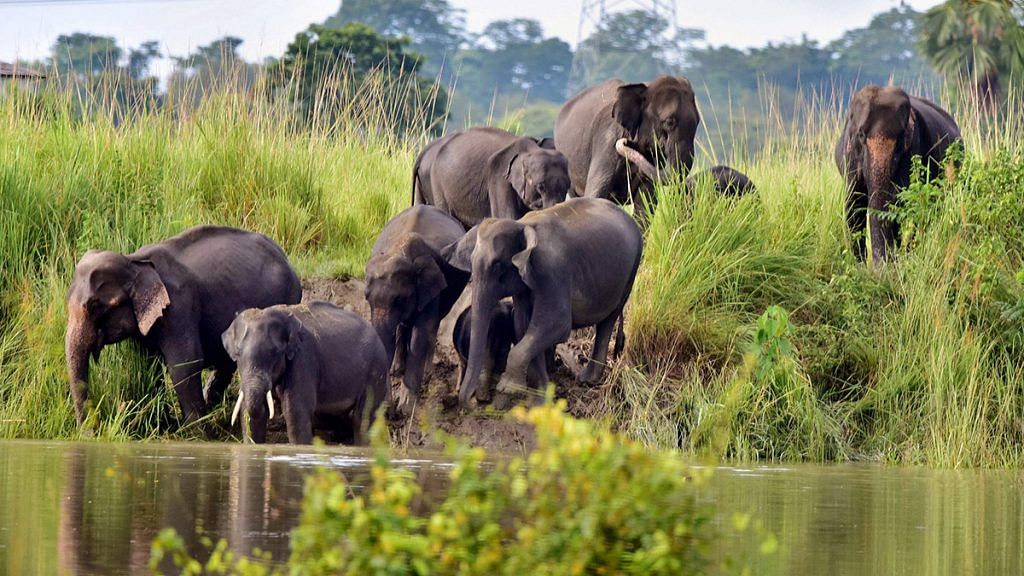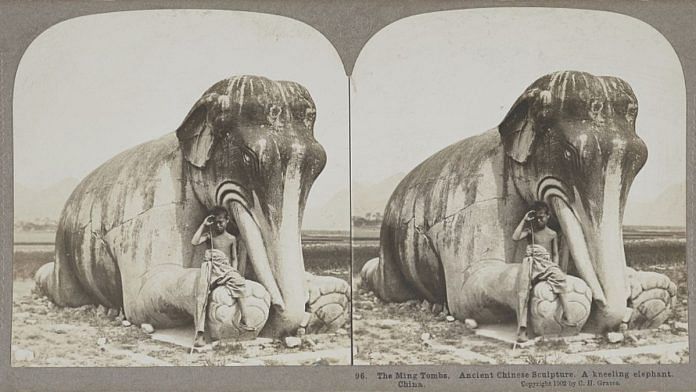Why are there no elephants in China? And why have large numbers of elephants always existed throughout the Indian subcontinent? Why was there such a drastic divergence in the destiny of the elephant in these two Asian giants? Professor Thomas Trautmann’s book Elephants and Kings: An Environmental History provides lucid answers to these questions, thereby opening up the ecological histories of India and China.
Paleontological evidence and written records show that wild elephants were once abundant throughout China from at least 5000 BCE until around the beginning of the common era. What, then, caused the steady retreat of the Chinese elephant until its final disappearance? Trautmann demonstrates that the fate of the elephant—and the ecological histories of China and India—are anchored in the two distinct “land ethics” of these countries.
The concept of land ethic was first developed by the American environmentalist Aldo Leopold, who defined it as follows: “The land ethic simply enlarges the boundaries of the community to include soils, waters, plants, and animals, or collectively: the land . . . [A] land ethic changes the role of Homo sapiens from conqueror of the land community to plain member and citizen of it. It implies respect for his fellow-members, and also respect for the community as such.”
- Agriculture: Wild elephants were once abundant in China until an imperial focus on agricultural expansion led to habitat loss and their eventual disappearance.
- Land Ethic: In contrast, India’s complex land ethic—driven by military needs and economic priorities—helped preserve vast elephant habitats.
- War Elephants: The Indian war elephant spurred the creation of protected elephant forests (hastivana/gajavana), influencing statecraft and ecological practices.
- Ancient Statecraft: Ancient texts like Kautilya’s Arthashastra reveal a multifaceted approach to land management that balanced agriculture, recreation, religion, and wildlife conservation.
China’s agricultural mandate and India’s war elephant
In ancient China, the land ethic was focused centrally, if not exclusively, on maximising agricultural production—a duty deemed central to the emperor. This focus led to the clearing of forests and the killing or driving away of dangerous wild animals, including elephants. Clearing forest land for agriculture was both imperial duty and policy. The resultant loss of habitat was responsible for the gradual retreat of the Chinese elephant over about a millennium.
In India, by contrast, the land ethic was more complex and driven by different priorities. Although the economic imperative of food production was as central in India as it was in China, other competing and offsetting interests were also at play. The dominant competing interest was military. Here we come to the central protagonist of Trautmann’s narrative—the war elephant. Serving as a key component of ancient Indian armies several centuries before the common era, the war elephant was, according to Trautmann, an Indian invention unparalleled in human history.
This military imperative necessitated a different attitude toward land, creating a distinctive land ethic. Not all lands under the king’s domain were to be converted to agricultural use; a large percentage had to be left wild and forested to provide habitats for elephants, whose herds required expansive territory for survival and success. It was from these wild populations that elephants deemed suitable for military training were captured, as elephants were generally not bred in captivity. Thus, from the war elephant was born the elephant forest—called hastivana and later gajavana in Sanskrit.

Elephant forests figure prominently in Kautilya’s Arthashastra, the oldest and most famous treatise on statecraft from ancient India. Dating to around the beginning of the common era, this text lists eight regions of elephant forests spread throughout northern and central India. A separate government department, headed by the Superintendent of Elephants, or hastyadhyaksha, was dedicated to managing elephants. A veritable science developed concerning the capture, training, diet, and veterinary care of elephants, as well as the maintenance and supervision of their habitats, which included forest wardens and guards to prevent poaching.
The beneficial side effects of these elephant forests may have been unintended, but they were real. From an ecological perspective, the institution of the war elephant gave rise to a land ethic in India with strong and lasting benefits—large tracts of land were left as sanctuaries for elephants, allowing other fauna and flora to flourish.
The Indian land ethic, however, was multifaceted. The first facet beyond the war elephant is economic. A strictly economic purpose in maintaining forests is revealed in Kautilya’s reference to a second kind of forest whose purpose was specifically economic. He uses two names for it: kupya-vana or dravya-vana. “[The king] should also establish a forest for each product classified as forest produce [kupya]” (Arthashastra 2.2.5). These produce forests—what we would call ‘managed forests’—fell under the jurisdiction of a mid-level bureaucrat known as the ‘Superintendent of Forest Produce’ [kupya-adhyakṣa, Arthashastra 2.17]. Kautilya advises him to employ guards in these forests.
India’s land ethic: Economic, recreational, religious, aesthetic
Another facet of the land ethic pertains to hunting and recreation—specifically, the establishment of forests for the royal hunt. Such forests are called mriga-vana, or game forests. Kautilya writes: “He should get an animal reserve … established for the king’s relaxation” (Arthashastra 2.2.3).
A further facet is religious. At the very beginning of the chapter on elephant and produce forests, Kautilya calls for setting aside wild tracts for religious purposes: “He should allot wild tracts (aranya) to ascetics (tapasvin) for Vedic study and Soma sacrifice . . . where all mobile and immobile creatures have been granted immunity from harm (abhaya)” (Arthashastra 2.2.2). The connection of forests to ascetic austerities or tapas has been long noted, and the expression tapo-vana—penance grove—is frequently encountered in Sanskrit literature.
Yet another aspect of the Indian land ethic is a land aesthetic. This is revealed in a different kind of forest that Kautilya instructs the king to establish, where hunting, fishing, and other forms of natural resource exploitation were strictly forbidden. Because of this, they bear the name abhayavana, or sanctuary (Arthashastra 2.26.1). The term abhaya, literally ‘non-fear’, signifies that the animals living there would have no fear of being killed. These forest preserves come closest to the modern concept of national parks or wildlife refuges. As Kautilya states: “At its [game reserve’s] border or as dictated by the lay of the land, he should get another animal reserve established where all the animals are treated as guests” [Arthashastra 2.2.4].
The religious and aesthetic aspects of the forest in the ancient Indian imagination are significant elements in constructing an Indian land ethic that fostered the conservation of various wooded habitats, including those suited for elephants. In this context, we can speak not only of a land ethic but also of a land aesthetic.
At the very beginning of his chapter on establishing various kinds of forests, Kautilya makes a curious yet significant comment: “On land unsuitable for agriculture (akṣyāyāṃ bhūmau), he should allot pastures for farm animals” (Arthashastra 2.2.1). It is on such land that elephant forests, produce forests, and penance groves for ascetics were established.
This comment reveals that Kautilya was urging the king to conduct an ecological evaluation of the land—to distinguish between lands that would be agriculturally productive and those better suited for other purposes, including preservation as forested areas. If this was indeed a deliberative process, then Kautilya’s land ethic can be considered the outcome of a rational process of land management, adding yet another dimension to the multifaceted land ethic of ancient India.
Patrick Olivelle is Professor Emeritus of Asian Studies at the University of Texas at Austin. He is known for his work on early Indian religions, law, and statecraft. Views are personal.
(Edited by Prashant)





How do you say there are no elephants in China? What about that herd of elephants which walked across China a few years ago, and captivated the world?
The Chinese must stop eating all animals. They have driven countless animals and species to extinction simply because of this bizarre addiction. Every animal is not food.
Not really. The Chinese ate their elephants. Hence, none are left.